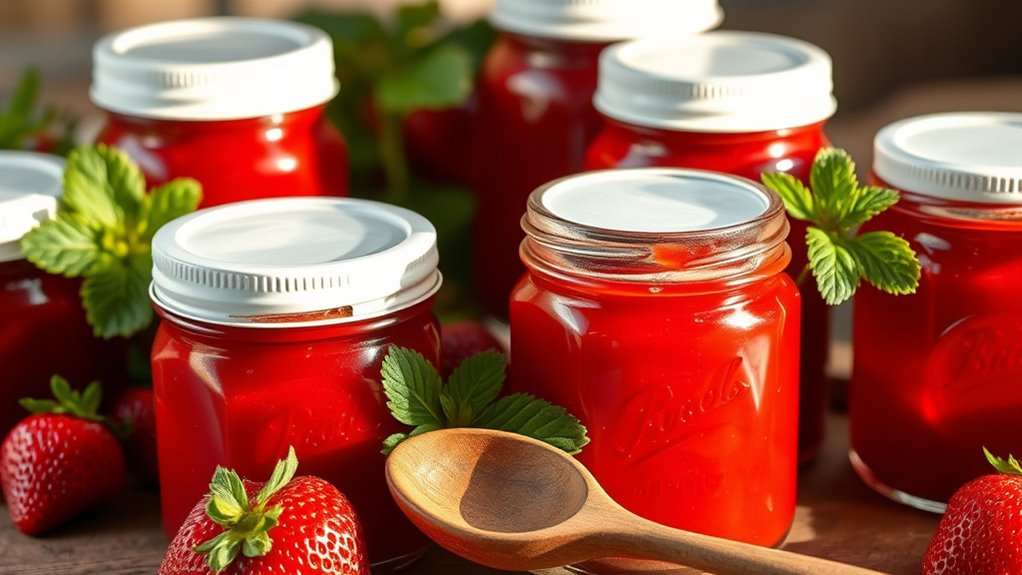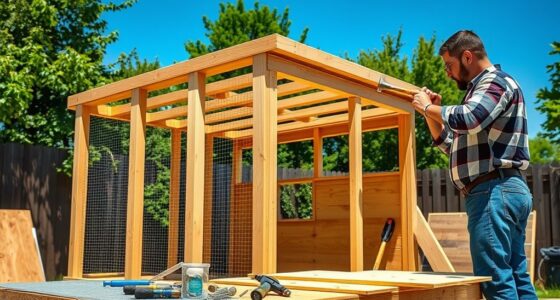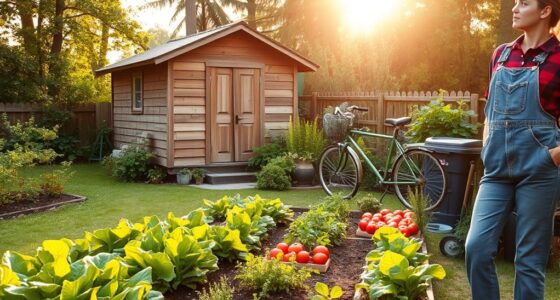Preserving food through canning requires careful sterilization, precise filling, and proper sealing, all aimed at creating a vacuum that keeps bacteria out. You need the right equipment, follow tested recipes, and understand safety practices to guarantee your preserves last. Whether you’re new to canning or want to improve your technique, mastering these basics can make all the difference. Ready to discover how to keep your foods fresh and flavorful for months to come?
Key Takeaways
- Properly sterilize jars and lids to prevent bacteria growth and prolong shelf life.
- Use the appropriate canning method—water bath or pressure canning—based on food acidity.
- Seal jars correctly to create a vacuum and ensure safe preservation.
- Store canned goods in a cool, dark place and check for spoilage before consumption.
- Follow tested recipes and guidelines for safe processing and maintaining quality.
Understanding the Basics of Canning
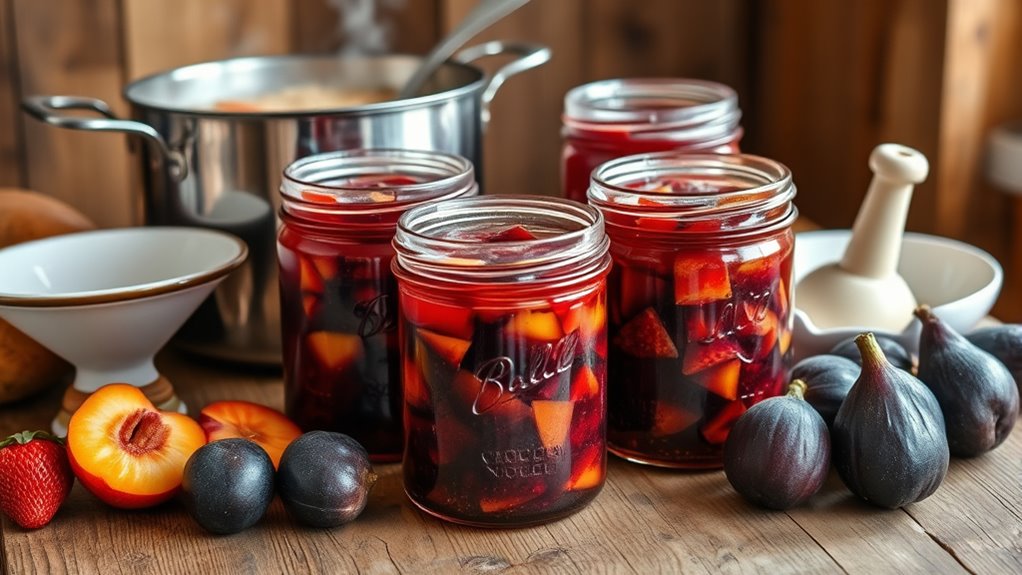
Have you ever wondered how to safely preserve fresh produce for long-term storage? Canning is a great way to do this while maintaining the natural botanical flavors of fruits and vegetables. The key is understanding the basics, starting with jar sterilization. Properly sterilizing your jars ensures no bacteria or spoilage organisms survive, giving your preserved foods a longer shelf life. Follow manufacturer guidelines for cleaning and maintaining canning equipment to ensure safety and effectiveness.
When preparing jars, wash them thoroughly and boil them in water or run them through a dishwasher cycle. This step is essential before filling them with your prepared produce and sealing them. Using clean, sterilized jars helps lock in flavors and nutrients while preventing spoilage.
Once jars are sterilized, you’re ready to fill them with your delicious, fresh produce for safe, long-term storage.
Essential Equipment and Supplies

To successfully preserve food through canning, you’ll need essential equipment and supplies designed for safety and efficiency. First, invest in jar lifters—they make handling hot jars safe and easy.
Invest in jar lifters for safe, easy handling of hot jars during canning.
A boiling water bath is vital for processing high-acid foods; it ensures even heat distribution and proper sealing. You’ll also need canning jars with lids, a canning funnel to fill jars without mess, and a sturdy rack to hold jars during boiling.
A large, deep pot or canner is necessary for the water bath process. A timer helps keep track of processing times. Additionally, have a clean cloth or paper towels on hand for wiping jar rims before sealing.
These tools and supplies make the canning process safer, more effective, and less stressful. Proper equipment maintenance also ensures that your tools remain safe and effective over time.
Preparing and Processing Your Preserves
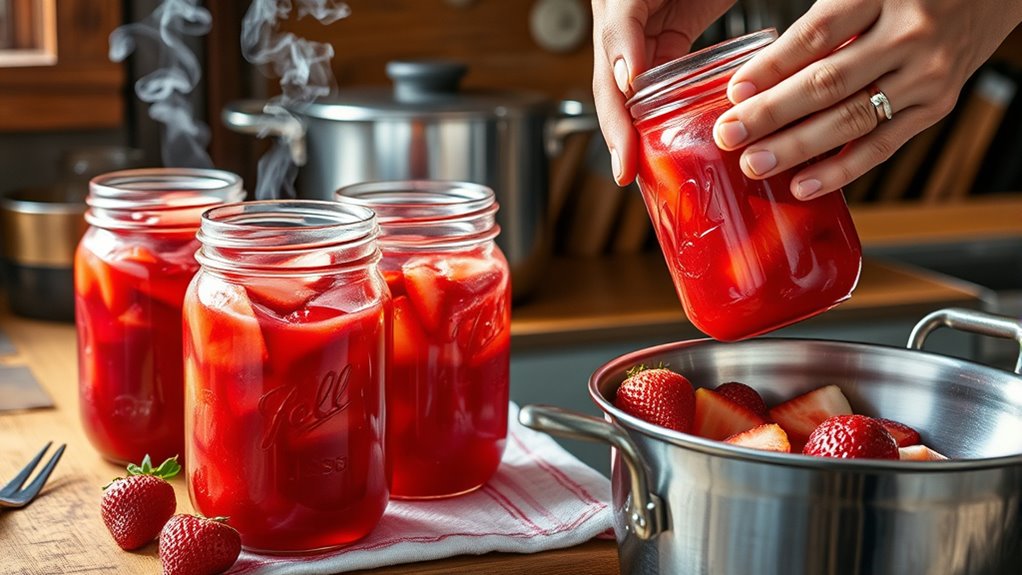
Before you start processing your preserves, it’s important to prepare the jars and ingredients properly. Clean jars and lids thoroughly to prevent contamination. For jam recipes, ensure your fruit is fresh and cooked to the right consistency before filling the jars. When it comes to pickling techniques, use vinegar and spices as specified in your recipes, and pack your vegetables tightly to maximize space. Seal jars properly to create a vacuum during processing. Processing involves boiling jars in a water bath or pressure canner, depending on the preserve type. This step destroys bacteria and helps preserve flavors. Follow recipe instructions precisely to ensure proper acidity and consistency. Additionally, understanding electric bike speeds can inform how you handle transportation or delivery of your preserves if needed. Proper preparation and processing are essential to achieving safe, delicious preserves that last.
Safety Tips for Successful Canning
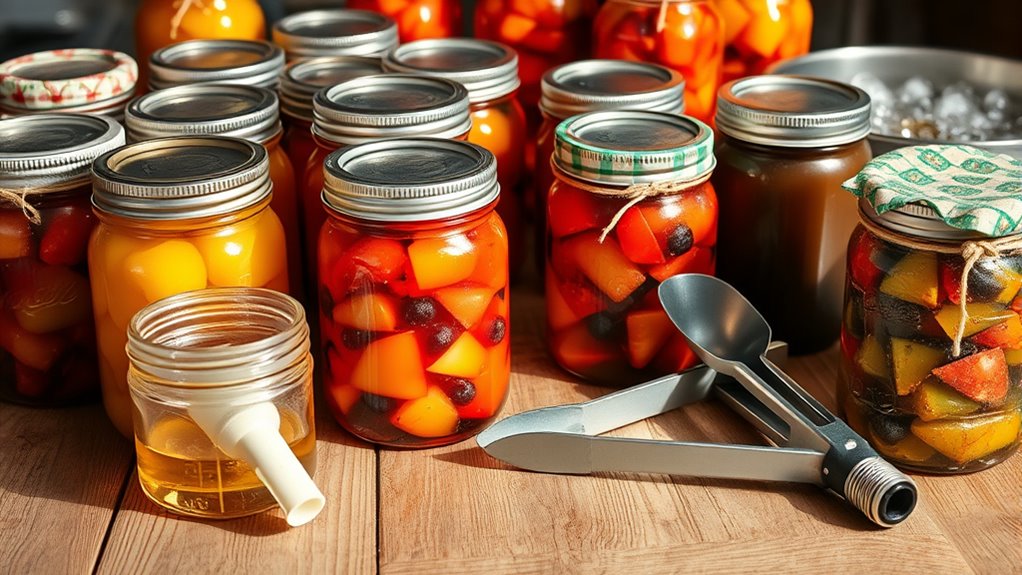
Ensuring safety during canning is essential to prevent spoilage and foodborne illnesses. Use proper lid sealing methods to guarantee a vacuum forms, preventing bacteria growth. When pickling, follow tested techniques to avoid acidity issues and mold. Always check jars for cracks and chips before filling. Use a boiling water bath or pressure canner suited for your produce. Label jars with date and contents for easy tracking. Consider the following:
| Pickling Techniques | Lid Sealing Methods |
|---|---|
| Use fresh, quality produce | Guarantee rims are clean and dry |
| Use proper vinegar and salt ratios | Tighten lids just enough to seal |
| Follow tested recipes | Listen for popping sound during sealing |
Adhering to these safety tips guarantees your canned goods stay safe and delicious. Proper canning procedures are vital to maintaining food quality and safety.
Storing and Enjoying Your Home-Canned Goods
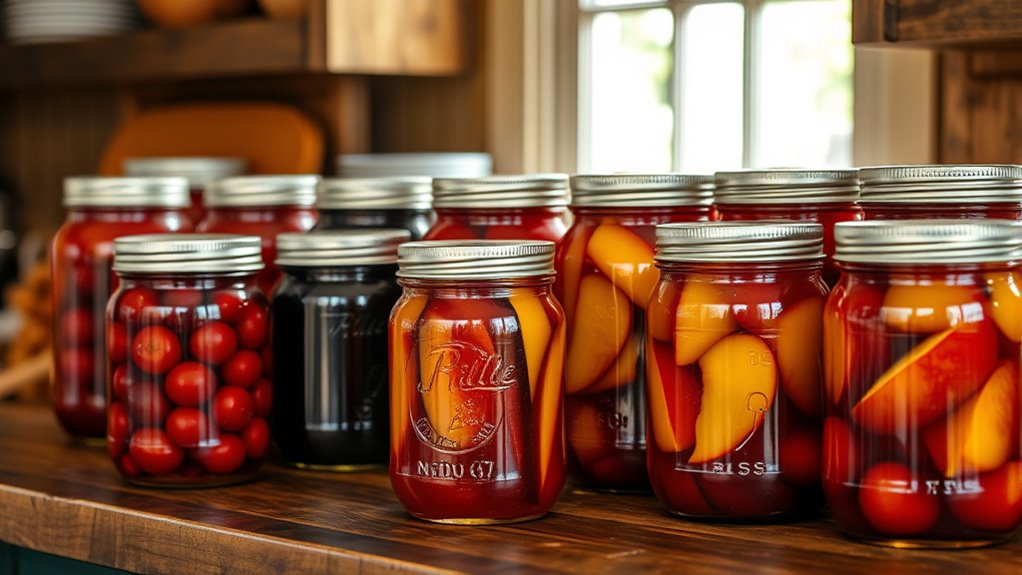
Once you’ve successfully canned your foods, proper storage guarantees they stay fresh and safe to enjoy. Store your jars in a cool, dark place away from direct sunlight and temperature fluctuations. Label each jar with the date and contents to keep track of freshness. Utilizing modern fixtures can help ensure your jars stay sealed and protected from contaminants. When you’re ready to enjoy your canned goods, consider the pickling techniques you used; they influence the flavor profile and shelf life. Experiment with flavor combinations like spicy peppers and garlic or sweet onions and herbs to add variety. Before opening, check for any signs of spoilage, such as bulging lids or off smells. Once opened, refrigerate and consume within a few days. Proper storage and mindful enjoyment preserve both the quality and safety of your home-canned treasures.
Frequently Asked Questions
How Long Can Canned Foods Be Safely Stored?
You can typically store canned foods safely for 1 to 5 years, depending on the type and storage conditions.
Always check for spoilage indicators like bulging lids, leaks, or off smells before consuming.
Proper storage duration depends on the food’s acidity and canning method.
Keep cans in a cool, dark place to extend shelf life, and always inspect them for signs of spoilage to guarantee safety.
Can I Reuse Canning Jars and Lids?
Ever wonder if you can reuse canning jars and lids? You can, but with caution. Always sterilize jars thoroughly before reuse and inspect lids for any damage or rust—it’s best to replace them to guarantee a proper seal.
Reusing jars is eco-friendly, but never reuse lids more than once, as they mightn’t seal properly the second time. Proper jar sterilization and lid replacement keep your canned food safe.
What Are the Signs of Spoiled Canned Food?
When checking for spoiled canned food, start with a visual inspection. Look for bulging lids, leaks, or discoloration, which indicate spoilage. Also, note any foul odors or mold. These signs help you identify botulism risks and other bacteria.
If anything seems off, avoid tasting the food. Properly stored canned items should remain safe, but always prioritize safety and discard any suspect jars immediately.
How Do I Adjust Processing Times for Altitude?
When adjusting processing times for altitude, you need to take into account altitude adjustment guidelines because higher elevations require longer processing times to ensure safety.
You should increase the processing time according to your altitude—generally, add 5 minutes for every 1,000 feet above sea level.
Always consult a reliable canning chart or guidelines to determine the correct altitude adjustment for your specific elevation, ensuring your canned foods remain safe and shelf-stable.
Can I Can Low-Acid Foods Safely at Home?
Sure, you can can low-acid foods at home—if you’re willing to risk botulism. While acidic foods benefit from natural safety, low-acid items need proper sterilization methods and pressure canning.
Without these precautions, you’re bypassing safety protocols that prevent dangerous bacteria growth. So, if you’re serious about preserving low-acid foods, follow tested recipes and guidelines, because shortcuts could turn your kitchen into a health hazard.
Conclusion
Now that you know the essentials of canning, you’ll be able to enjoy homemade preserves safely and confidently. Did you know that properly processed home-canned foods can last up to a year or more? By following safety tips and using the right equipment, you’ll preserve flavors and nutrients for months to come. So get your jars ready, and start creating delicious, lasting treasures from your garden or market finds!

